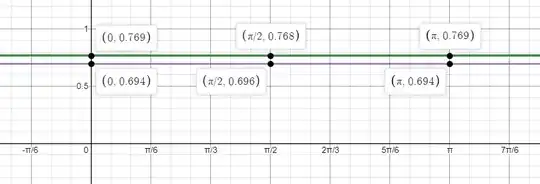I'm interested in the behaviour of applying the same function repeatedly or oscillating between applying two different functions repeatedly. Let me explain.
If I wanted to know what happens when I square $x$ repeatedly, i.e.: $${{\left({\left({\left(x^2\right)}^2\right)}^2\right)}^2}^{...}$$ I know that this is essentially $$x^{2^{n}},\qquad n=1,2,3,...$$ So I know that if I was to graph $f(x)=x^{2^{4}}$ I'd be graphing what happens if I square $x$ four times.
Similarly, if I wanted to oscillate between squaring and cubing, as in $${{\left({\left({\left(x^2\right)}^3\right)}^2\right)}^3}^{...}$$ then I would find that this is essentially $$x^{\frac{1}{2}\bigl(3-\left(-1\right)^n\bigr)\times6^{\lfloor\frac{n}{2}\rfloor}},\qquad n=1,2,3,...$$ (I had to look up the sequence of numbers, $2,6,12,36,72,...$ that results from $2\times3\times2\times3\,...$ to find a function that would work here). I know that for this if I input $n=3$ I've squared, then cubed, then squared again.
I realise that the examples so far are fairly identical, always producing graphs of $x$ to a positive even number so that as $n\to\infty$ they are the same square bottomed curve in the positive $f(x)$ portion of the plane. However, what I'm more interested in would be repeating a function like $$\sin(\sin(\sin(...\sin(\sin(x))...)))$$ or something which oscillates like $$\sin(\cos(\sin(\cos(...\sin(\cos(x))...))))$$ which can be denoted as $f(x)=\sin(\cos(x))$ and then adopt the iteration notation of $f^{\,n}(x)$ where $f^{\,2}(x)=f(f(x))$ and so on with $n\to\infty$
Can these be written in a simpler form?
I plotted the oscillating version of this repeated function for starting with $\mathrm{sine}$ or starting with $\mathrm{cosine}$ for several iterations and obtained the following results:

 As you cans see, after several iterations they are barely sinusoidal in nature at all and are closer to a straight line parallel to the $x$-axis, although there's barely just still some peaks and troughs (some have been highlighted). Is there any reason why they seem to approximate two numbers, namely $y\approx0.695$ for the purple graph and $y\approx0.768$ for the green graph? Is it possible to know these numbers exactly if we could perform the oscillation of functions many many times and solve?
As you cans see, after several iterations they are barely sinusoidal in nature at all and are closer to a straight line parallel to the $x$-axis, although there's barely just still some peaks and troughs (some have been highlighted). Is there any reason why they seem to approximate two numbers, namely $y\approx0.695$ for the purple graph and $y\approx0.768$ for the green graph? Is it possible to know these numbers exactly if we could perform the oscillation of functions many many times and solve?